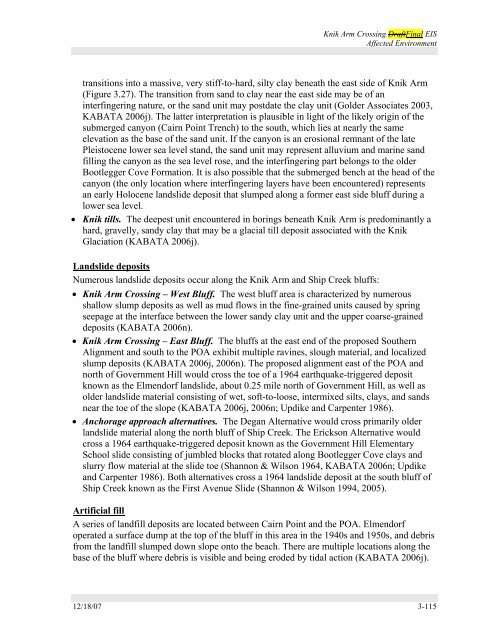3.0 Affected Environment - Knik Arm Bridge and Toll Authority
3.0 Affected Environment - Knik Arm Bridge and Toll Authority
3.0 Affected Environment - Knik Arm Bridge and Toll Authority
Create successful ePaper yourself
Turn your PDF publications into a flip-book with our unique Google optimized e-Paper software.
<strong>Knik</strong> <strong>Arm</strong> Crossing DraftFinal EIS<br />
<strong>Affected</strong> <strong>Environment</strong><br />
transitions into a massive, very stiff-to-hard, silty clay beneath the east side of <strong>Knik</strong> <strong>Arm</strong><br />
(Figure 3.27). The transition from s<strong>and</strong> to clay near the east side may be of an<br />
interfingering nature, or the s<strong>and</strong> unit may postdate the clay unit (Golder Associates 2003,<br />
KABATA 2006j). The latter interpretation is plausible in light of the likely origin of the<br />
submerged canyon (Cairn Point Trench) to the south, which lies at nearly the same<br />
elevation as the base of the s<strong>and</strong> unit. If the canyon is an erosional remnant of the late<br />
Pleistocene lower sea level st<strong>and</strong>, the s<strong>and</strong> unit may represent alluvium <strong>and</strong> marine s<strong>and</strong><br />
filling the canyon as the sea level rose, <strong>and</strong> the interfingering part belongs to the older<br />
Bootlegger Cove Formation. It is also possible that the submerged bench at the head of the<br />
canyon (the only location where interfingering layers have been encountered) represents<br />
an early Holocene l<strong>and</strong>slide deposit that slumped along a former east side bluff during a<br />
lower sea level.<br />
• <strong>Knik</strong> tills. The deepest unit encountered in borings beneath <strong>Knik</strong> <strong>Arm</strong> is predominantly a<br />
hard, gravelly, s<strong>and</strong>y clay that may be a glacial till deposit associated with the <strong>Knik</strong><br />
Glaciation (KABATA 2006j).<br />
L<strong>and</strong>slide deposits<br />
Numerous l<strong>and</strong>slide deposits occur along the <strong>Knik</strong> <strong>Arm</strong> <strong>and</strong> Ship Creek bluffs:<br />
• <strong>Knik</strong> <strong>Arm</strong> Crossing – West Bluff. The west bluff area is characterized by numerous<br />
shallow slump deposits as well as mud flows in the fine-grained units caused by spring<br />
seepage at the interface between the lower s<strong>and</strong>y clay unit <strong>and</strong> the upper coarse-grained<br />
deposits (KABATA 2006n).<br />
• <strong>Knik</strong> <strong>Arm</strong> Crossing – East Bluff. The bluffs at the east end of the proposed Southern<br />
Alignment <strong>and</strong> south to the POA exhibit multiple ravines, slough material, <strong>and</strong> localized<br />
slump deposits (KABATA 2006j, 2006n). The proposed alignment east of the POA <strong>and</strong><br />
north of Government Hill would cross the toe of a 1964 earthquake-triggered deposit<br />
known as the Elmendorf l<strong>and</strong>slide, about 0.25 mile north of Government Hill, as well as<br />
older l<strong>and</strong>slide material consisting of wet, soft-to-loose, intermixed silts, clays, <strong>and</strong> s<strong>and</strong>s<br />
near the toe of the slope (KABATA 2006j, 2006n; Updike <strong>and</strong> Carpenter 1986).<br />
• Anchorage approach alternatives. The Degan Alternative would cross primarily older<br />
l<strong>and</strong>slide material along the north bluff of Ship Creek. The Erickson Alternative would<br />
cross a 1964 earthquake-triggered deposit known as the Government Hill Elementary<br />
School slide consisting of jumbled blocks that rotated along Bootlegger Cove clays <strong>and</strong><br />
slurry flow material at the slide toe (Shannon & Wilson 1964, KABATA 2006n; Updike<br />
<strong>and</strong> Carpenter 1986). Both alternatives cross a 1964 l<strong>and</strong>slide deposit at the south bluff of<br />
Ship Creek known as the First Avenue Slide (Shannon & Wilson 1994, 2005).<br />
Artificial fill<br />
A series of l<strong>and</strong>fill deposits are located between Cairn Point <strong>and</strong> the POA. Elmendorf<br />
operated a surface dump at the top of the bluff in this area in the 1940s <strong>and</strong> 1950s, <strong>and</strong> debris<br />
from the l<strong>and</strong>fill slumped down slope onto the beach. There are multiple locations along the<br />
base of the bluff where debris is visible <strong>and</strong> being eroded by tidal action (KABATA 2006j).<br />
12/18/07 3-115
















